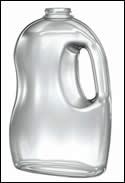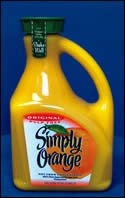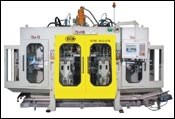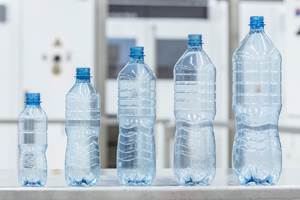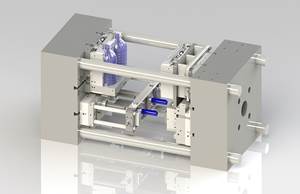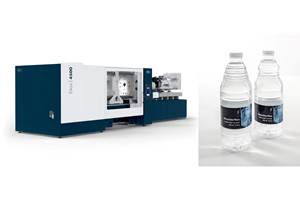Is Clear Handleware Ready for Prime Time?
Clear handled bottles got a kick start earlier this year when nationally recognized Simply Orange Juice Co., Apopka, Fla., an affiliate of the Minute Maid division of The Coca-Cola Co., decided to bottle its orange juice in extrusion blow molded 89-oz copolyester containers.
Clear handled bottles got a kick start earlier this year when nationally recognized Simply Orange Juice Co., Apopka, Fla., an affiliate of the Minute Maid division of The Coca-Cola Co., decided to bottle its orange juice in extrusion blow molded 89-oz copolyester containers. Until now, clear containers with an integral handle have been an elusive goal. Some clear bottles have been stretch-blow molded and incorporated separate snap-on handles. And there has been limited success in extrusion blow molding containers of clarified PP and PVC. In those cases, the prime obstacles were the material’s lack of melt strength, brittleness, and inability to pass drop-impact tests.
Improved copolyester
Resin maker Eastman Chemical Co. and machine builder Bekum America Corp. teamed up more than three years ago to tackle this attractive high-growth market. The interest in clear handled containers was clearly evident at a recent Bekum open house and technical seminar attended by many food and beverage companies, bottlers, and blow molders. The first two clear handled applications—a 64-oz Indian River Select orange juice bottle in 2005 and a 48-oz POM Wonderful pomegranate juice container in 2006—were small-volume applications that validated the new copolyester developed by Eastman and Bekum’s extrusion blow technology. Now, the high-volume application at Simply Orange has many wondering if clear handled containers have arrived in force.
Some of the early success and optimism is attributed to Eastman’s Eastar EB062 copolyester, introduced in 2004. It is claimed to perform better than Eastman’s E-PET which was first offered to extrusion blow molders in the early 1990s. That material got poor reviews and gave extrusion blow molders a sour taste for polyesters in handleware. Eastman notes that EB062 is not PETG, but a branched amorphous copolyester. Its melt strength is twice that of PETG and similar to that of polycarbonate, Eastman says. It also boasts better toughness than other copolyesters and better drop impact as well. Its clarity and organoleptics (taste and odor) also beat those of PVC, according to Eastman.
The material has a processing temperature of 450 F. Maintaining that melt temperature is critical because excess heat can reduce melt strength. The material also sets up more quickly than HDPE and PVC, and shrinkage is less than that of HDPE. Eastman notes that bottle and mold design and process setup are important considerations in optimizing drop impact. In addition, proper drying is critical to avoid a reduction in the material’s inherent viscosity.
Novel deflasher
On the machinery side, Bekum’s BM-406-D continuous-extrusion shuttle machine features a special in-machine deflasher for handleware. It acts like a peeling device and emulates a hand-trim operation. The peeling action results in less effect on the part and helps to maintain its drop-impact properties. The machine also features a simple linear cold-knife system, said to be unique in polyester bottle making, instead of the usual and more complicated hot knife.
The machine has two parisons per side, whose large diameter is said to aid processing and control of handled containers. A smooth-bore extruder of up to 120 mm diam. and 24:1 L/D is claimed to minimize shear heating and preserve melt strength. The machine also uses standard Bekum BKZ polyolefin extrusion heads and clamp force of 8 to 10 tons per cavity.
The Simply Orange containers have a 43-mm neck finish. At a recent Bekum demonstration, a four-cavity machine made 2-liter bottles in an 11-sec cycle at 1300 bottles/hr. Containers up to 10L can be made at 1000/hr. Both the Indian River and Simply Orange bottles are molded by CKS Packaging Inc., Atlanta. Other applications include organic milk, edible oil, and laundry care. Bekum and Eastman are also working on clear coextruded barrier handleware for similar applications.
Related Content
First Water Bottles With Ultrathin Glass Coating
Long used for sensitive juices and carbonated soft drinks, KHS Freshsafe PET Plasmax vapor-deposited glass coating is now providing freshness and flavor protection for PET mineral water bottles.
Read MoreAt NPE, Cypet to Show Latest Achievements in Large PET Containers
Maker of one-stage ISBM machines will show off new sizes and styles of handled and stackable PET containers, including novel interlocking products.
Read MoreEnd-to-End Quality Management For Aseptic PET Beverage Bottling
Sidel introduces Qual-IS comprehensive quality system to merge all QC activities in PET aseptic beverage bottling, from the preform blowing to laboratory management.
Read MoreKrones Acquires Netstal
Krones adds PET preform injection molding to its bottle blowing and filling capabilities, as well as cap molding and expansion into medical, food and other markets.
Read MoreRead Next
Beyond Prototypes: 8 Ways the Plastics Industry Is Using 3D Printing
Plastics processors are finding applications for 3D printing around the plant and across the supply chain. Here are 8 examples to look for at NPE2024.
Read MoreLead the Conversation, Change the Conversation
Coverage of single-use plastics can be both misleading and demoralizing. Here are 10 tips for changing the perception of the plastics industry at your company and in your community.
Read MoreMaking the Circular Economy a Reality
Driven by brand owner demands and new worldwide legislation, the entire supply chain is working toward the shift to circularity, with some evidence the circular economy has already begun.
Read More



